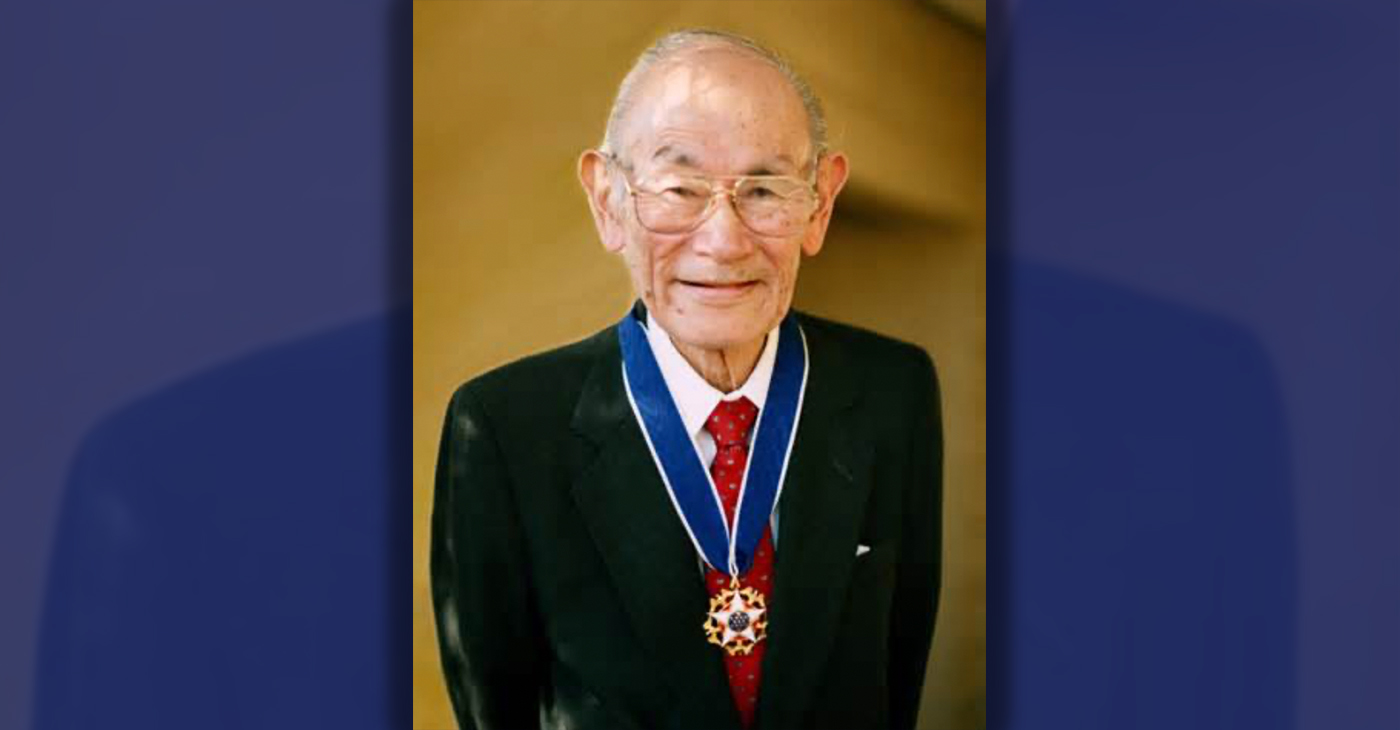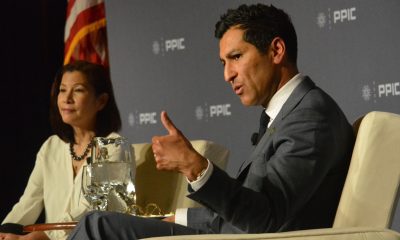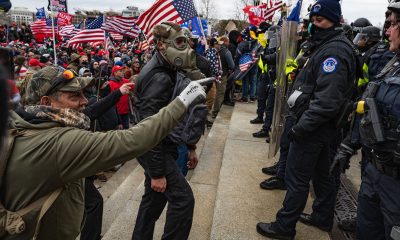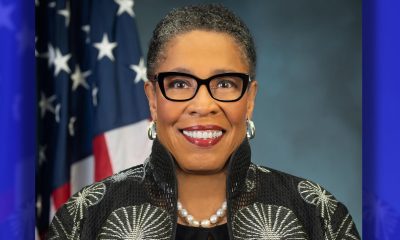Community
Our Black Women and Girls Have Gone Missing but Few Seem to Care
NNPA NEWSWIRE — “To recognize Black girls as magical means defining them as precious, unique and valued. When society recognizes their worth and value, I believe that more attention will be paid to this matter. In addition, it will call for all people to recognize this as an epidemic and cause for action,” said Ginger Lavender Wilkerson, a licensed marriage and family therapist in Los Angeles.
By Stacy M. Brown, NNPA Newswire Correspondent
@StacyBrownMedia
Victoria Shaw, a Black girl approximately 15 years old, went missing Monday, Feb. 11, in West Hartford, Connecticut.
Teandah Slater, Black and also only 15 years old, was reported missing on Thursday, Feb. 7, from Noble Square in Chicago.
Areall Murchinson, a 16-year old Black girl, was last seen near the 200 block of West 111th Place, according to a community alert from Chicago police.
The three are the most recent to make the dubious and heart-breaking list of missing Black girls – particularly teens.
It’s a list that’s quite long and there remains no update on their status.
Recently, the nonprofit Black & Missing Foundation compiled statistics from the FBI which noted that in 2016 alone, 242,295 individuals of color were reported missing in the United States.
A stunning 36.7 percent of those missing were Black teens under the age of 18.
In total, statistics show more than 75,000 young Black Americans are currently missing.
What’s more, officials at the National Center for Missing and Exploited Children’s CyberTipline said they’ve received more than 18.4 million reports, most of which led to apparent child sexual abuse images: online enticement (including “sextortion”), child sex trafficking and child sexual molestation.
Those statistics, and the seeming lack of media interest, have led to cries of racism and neglect, particularly when it comes to Black girls.
It has also led La’Tasha D. Mayes to pen the essay, “Why the Crisis of Missing Black Girls Needs More Attention Than It’s Getting.” Mayes’ March 2017 essay was published at Ebony.com where she noted that an academic study analyzed news coverage of missing children and found that only 20 percent of reported stories focused on missing Black children. This, despite the fact that Black children account for 33 percent of total missing children cases.
“In other words, missing Black youth are grossly underreported in the news. For missing girls, it’s even worse. When Black girls go missing, far too many people don’t know or don’t care,” Mayes wrote.
Many argue that the stories of young Black girls and women who are missing don’t get the same degree of local, national and global attention as that of an Elizabeth Smart or Natalee Holloway.
Smart, a 14-year-old white girl, was kidnapped in 2002 from her home in Salt Lake City, Utah. After an intense search that included relentless media coverage, Smart was rescued by police nine months later and, among other activities, she’s become an analyst for ABC News.
Holloway disappeared in 2005 while on a high school graduation trip in Aruba.
The white Alabama teen’s story drew global media coverage and, although her remains were never found, she was declared dead in 2010.
Many maintain that African Americans aren’t afforded the intense police investigations or the media coverage given to whites that go missing.
“Black girls are magical and should be noticed, uplifted and acknowledged, both within and outside of the Black community,” said Ginger Lavender Wilkerson, a licensed marriage and family therapist in Los Angeles.
“To recognize Black girls as magical means defining them as precious, unique and valued. When society recognizes their worth and value, I believe that more attention will be paid to this matter. In addition, it will call for all people to recognize this as an epidemic and cause for action,” Wilkerson said.
Child Rights activist Katerina Canyon said she’s been researching cases of missing Black girls for years and there are several unknowns, including that many go missing without any witnesses. “This leads me to believe that the kidnappers are either very good at what they’re doing, or the girls left on their own,” Canyon said.
“We need to make sure black girls have readily accessible help from adults in a safe environment such that they do not fall victim to homelessness or trafficking. A lot of times, with the proper interventions, we can prevent black girls from leaving home or falling prey to traffickers,” she said.
The mystery of the disappearances also has heightened since 2016 when Donald Trump won the presidency and the subsequent rise in nationalism and white supremacy.
Some of the disappearances have proven more suspicious than others.
A recent report highlighted the case of Amber Evans, who disappeared in 2015.
Evans had been a key player and driving force behind state and local juvenile justice reform in Ohio – work for which she’d been rewarded when the organization she worked for, the Juvenile Justice Coalition, put her in charge.
In a Facebook post on her first day as executive director, Evans, 28, displayed her track and field medals.
“Ohio is for champions and I used to be something of a track star,” Evans wrote.
“Wearing my old medals before starting day 1 as executive director of the Juvenile Justice Coalition was a nice reminder of that.”
Three weeks later, Evans disappeared.
Her car was found, purse in the trunk, her last known whereabouts, a stop at the pharmacy. Her last known words, a text to her mother saying, “I love you and I’m sorry.”
“There never seemed to be a sense of urgency for our missing African American girls,” said Nashima Harvey, an educator and founder of Girls of Decision, a youth empowerment group that seeks to assist girls in making better choices in all stages of their lives.
“The sad thing that I have encountered has been that many of the young girls I have interacted with on my journey are young women who were former human trafficked young ladies,” Harvey said.
“These women went missing at the ages of 12 to 14 and are now adults living in toxic situations looking for a better life and all seemed to feel no longer welcomed by their family. I am grateful for the opportunity to work with this population, but I do believe that we need to be diligent and outspoken when it comes to saving our girls,” she said.
Activism
Oakland Post: Week of April 17 – 23, 2024
The printed Weekly Edition of the Oakland Post: Week of April 17 – 23, 2024

To enlarge your view of this issue, use the slider, magnifying glass icon or full page icon in the lower right corner of the browser window. ![]()
Activism
Oakland Schools Honor Fred Korematsu Day of Civil Liberties
Every Jan. 30, OUSD commemorates the legacy of Fred Korematsu, an Oakland native, a Castlemont High School graduate, and a national symbol of resistance, resilience, and justice. His defiant stand against racial injustice and his unwavering commitment to civil rights continue to inspire the local community and the nation. Tuesday was “Fred Korematsu Day of Civil Liberties and the Constitution” in the state of California and a growing number of states across the country.

By Post Staff
Every Jan. 30, OUSD commemorates the legacy of Fred Korematsu, an Oakland native, a Castlemont High School graduate, and a national symbol of resistance, resilience, and justice.
His defiant stand against racial injustice and his unwavering commitment to civil rights continue to inspire the local community and the nation. Tuesday was “Fred Korematsu Day of Civil Liberties and the Constitution” in the state of California and a growing number of states across the country.
One OUSD school is named in his honor: Fred T. Korematsu Discovery Academy (KDA) elementary in East Oakland.
Several years ago, founding KDA Principal Charles Wilson, in a video interview with anti-hate organization “Not In Our Town,” said, “We chose the name Fred Korematsu because we really felt like the attributes that he showed in his work are things that the children need to learn … that common people can stand up and make differences in a large number of people’s lives.”
Fred Korematsu was born in Oakland on Jan. 30, 1919. His parents ran a floral nursery business, and his upbringing in Oakland shaped his worldview. His belief in the importance of standing up for your rights and the rights of others, regardless of race or background, was the foundation for his activism against racial prejudice and for the rights of Japanese Americans during World War II.
At the start of the war, Korematsu was turned away from enlisting in the National Guard and the Coast Guard because of his race. He trained as a welder, working at the docks in Oakland, but was fired after the bombing of Pearl Harbor in 1941. Fear and prejudice led to federal Executive Order 9066, which forced more than 120,000 Japanese Americans out of their homes and neighborhoods and into remote internment camps.
The 23-year-old Korematsu resisted the order. He underwent cosmetic surgery and assumed a false identity, choosing freedom over unjust imprisonment. His later arrest and conviction sparked a legal battle that would challenge the foundation of civil liberties in America.
Korematsu’s fight culminated in the Supreme Court’s initial ruling against him in 1944. He spent years in a Utah internment camp with his family, followed by time living in Salt Lake City where he was dogged by racism.
In 1976, President Gerald Ford overturned Executive Order 9066. Seven years later, the 9th Circuit Court of Appeals in San Francisco vacated Korematsu’s conviction. He said in court, “I would like to see the government admit that they were wrong and do something about it so this will never happen again to any American citizen of any race, creed, or color.”
Korematsu’s dedication and determination established him as a national icon of civil rights and social justice. He advocated for justice with Rosa Parks. In 1998, President Bill Clinton gave him the Presidential Medal of Freedom saying, “In the long history of our country’s constant search for justice, some names of ordinary citizens stand for millions of souls … To that distinguished list, today we add the name of Fred Korematsu.”
After Sept. 11, 2001, Korematsu spoke out against hatred and discrimination, saying what happened to Japanese Americans should not happen to people of Middle Eastern descent.
Korematsu’s roots in Oakland and his education in OUSD are a source of great pride for the city, according to the school district. His most famous quote, which is on the Korematsu elementary school mural, is as relevant now as ever, “If you have the feeling that something is wrong, don’t be afraid to speak up.”
Community
For Cervical Cancer Month, Medical Community Focused on Education
January was Cervical Cancer Awareness Month. Physicians, advocates and others in the medical community commemorated the month by raising awareness about a form of cancer they say is highly preventable and treatable. Cervical cancer is caused by a virus called the human papillomavirus (HPV) and it develops slowly over time but can be prevented with proper care in girls as young as 13 years old.

By Magaly Muñoz
January was Cervical Cancer Awareness Month.
Physicians, advocates and others in the medical community commemorated the month by raising awareness about a form of cancer they say is highly preventable and treatable.
Cervical cancer is caused by a virus called the human papillomavirus (HPV) and it develops slowly over time but can be prevented with proper care in girls as young as 13 years old.
Sonia Ordonez, an OBGYN and gynecology surgeon at Kaiser Permanente, stated that as soon as people with cervixes reach the maturity reproductive age, they should start taking preventative measures like getting the HPV vaccine. The vaccine involves a series of two-doses for people aged 9 through 14 or three-doses for people 15 through 45 years old.
“I see a lot of young women who can’t remember or may not have gotten [the vaccine] when they were younger, or maybe got one, but we can give them the series of vaccines and restart at any point in time,” Ordonez said.
She said that cervical cancer is not the only cancer caused by HPV. Strains of the virus can also lead to throat, anal and penile cancers.
Screening is also an effective way to check for cervical cancer and should be done every three years after someone turns 21, doctors recommend. It is best to start as early as possible to catch occurrences early.
Ordonez said that this cancer is also more likely found in people of color and has led to more deaths overall.
A Mayo Clinic article published last month stated that Black women are more likely to be diagnosed and die of cervical cancer, compared to White women in the U.S.
2,000 Black women are diagnosed every year with cervical cancer and 40% die as a result.
“This disparity is not due to genetic differences among White, Black or Hispanic women, but rather related to systemic racism, access to healthcare and socioeconomic factors,” Dr. Olivia Cardenas-Trowers, a Mayo Clinic urogynecologist, said in the article.
Ordonez stated that immigrant women are also highly susceptible to the cancer, as many Latin American countries may not have accessibility to screenings or lack of insurance makes it harder for them to get tested.
Hispanic women are 40% more likely to be diagnosed with cervical cancer, and 30% more likely to die from it, as compared to non-Hispanic White women, according to the Office of Minority Health.
Family medicine physician, Joy Anyanwu, stated that the pandemic contributed to hesitancy about getting cervical cancer screenings among some women. Other factors are people’s aversion to vaccines, parents not wanting to believe that their children are or will become sexually active, and doubt about the overall effectiveness of the vaccine.
“The vaccine is very safe — over 97% effective in preventing cervical cancer,” Anyanwu said. “Even if you aren’t having sex, the earlier you start would actually help.”
Anyanwu said she understands that parents might not want to ask questions about their children’s reproductive health, but it’s a mindset that can be a barrier to having important conversation about prevention or care.
To keep families their families and communties healthy, the doctor emphasized that people should prioritize keeping up with their vaccine series and going to screenings every year.
-

 Activism4 weeks ago
Activism4 weeks agoOakland Post: Week of March 20 – 26, 2024
-

 #NNPA BlackPress3 weeks ago
#NNPA BlackPress3 weeks agoCOMMENTARY: D.C. Crime Bill Fails to Address Root Causes of Violence and Incarceration
-

 #NNPA BlackPress3 weeks ago
#NNPA BlackPress3 weeks agoMayor, City Council President React to May 31 Closing of Birmingham-Southern College
-

 #NNPA BlackPress4 weeks ago
#NNPA BlackPress4 weeks agoFrom Raids to Revelations: The Dark Turn in Sean ‘Diddy’ Combs’ Saga
-

 #NNPA BlackPress4 weeks ago
#NNPA BlackPress4 weeks agoCOMMENTARY: Lady Day and The Lights!
-

 Activism3 weeks ago
Activism3 weeks agoOakland Post: Week of March 27 – April 2, 2024
-

 #NNPA BlackPress4 weeks ago
#NNPA BlackPress4 weeks agoBaltimore Key Bridge Catastrophe: A City’s Heartbreak and a Nation’s Alarm
-

 #NNPA BlackPress4 weeks ago
#NNPA BlackPress4 weeks agoBaltimore’s Key Bridge Struck by Ship, Collapses into Water


















































1 Comment